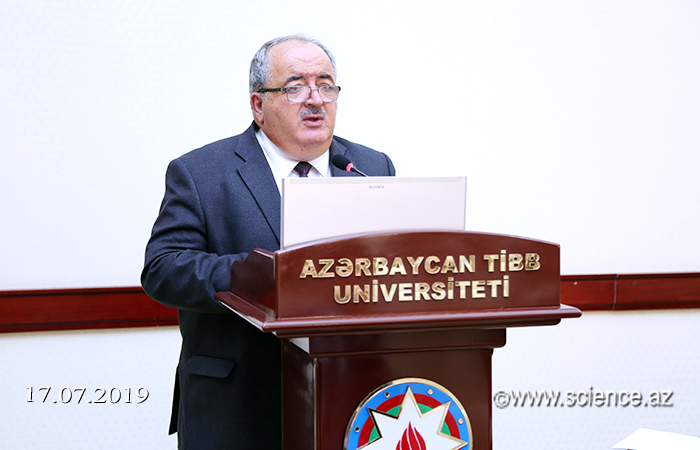New Research Methods for Oncology and Neurodegenerative Diseases Discussed
New Research Methods for Oncology and Neurodegenerative Diseases Discussed
On July 17, 2019, at the meeting of the Presidium of the Azerbaijan National Academy of Sciences (ANAS) held at the Teaching Therapeutic Clinic of Azerbaijan Medical University, an academic presentation was made by Professor Oktay Qasımov, Director of the Bioinformatics Institute of ANAS, on the topic “Multidisciplinary Research of Lung Cancer and Neurodegenerative Amyloid Diseases: Initial Results and Future Directions”.
The scholar pointed out that oncology and neurodegenerative diseases are among the most priority fields in modern biomedicine. He stated that in most economically developed countries, malignant tumors rank second as the cause of death, accounting for 18-23%, and that nearly 10% of the global population suffers from age-related neurodegenerative diseases. “Genetic, stress, and other factors play a key role in each of these diseases. There is a great need for the application of new, innovative, and multidisciplinary approaches to solve the medical-social problems created by these complex diseases.”
The presenter emphasized the importance of applying new screening methods that could detect the early stages of these diseases. He noted that this approach is crucial both for increasing patients’ life expectancy and recovery chances, and from an economic efficiency perspective. Oktay Qasımov mentioned that the work on predicting lung cancer using artificial intelligence, developed in collaboration with the Bioinformatics Institute of ANAS and the National Oncology Center of the Ministry of Health, has yielded successful results. “In the ‘Machine Learning’ phase, the blood plasma samples of healthy and diseased individuals have been classified using multivariate statistics with Fourier Transform Infrared spectra. The system has been optimized and verified when necessary. The machine uses this knowledge to classify unknown samples and make predictions. The developed system can identify healthy individuals with 80% accuracy and lung cancer patients with 90% accuracy. The continuation of these studies and the expansion of machine learning to improve the classification process is essential.”
Qasımov also discussed the temperature-dependent dynamics of the membrane of healthy and malignant tumor cells, which differ significantly from each other. He noted that the fluidity of malignant tumor cell membranes increases sharply with temperature, in contrast to healthy cells. Currently, artificial local hyperthermia is used to increase the effectiveness of chemotherapy and to enhance the radiosensitivity of tissues during radiation therapy.
The speaker highlighted the rapidly expanding multifaceted research on the morphology of malignant tumor cells. He explained that the cell microenvironment in tumor tissue is weakly acidic, whereas in normal cells, it is weakly alkaline. This difference can be exploited for rational treatment of the disease, and research in this direction has already begun. He emphasized that the research is being carried out in collaboration with the National Oncology Center, and the results are being discussed with specialists, including the renowned oncologist, academician Camal Aliyev.
Qasımov stated that modern medicine is moving toward personalized treatment, where drugs are selected, or even synthesized, specifically for each individual. He added that the same cancer disease could result from one or several mutations or damage to different genes. Therefore, mutations in each cancer patient must be identified, and corresponding drugs selected. He pointed out that there is a need to create a cellular technologies base at the Bioinformatics Institute of ANAS to develop the direction of personalized treatment in response to modern challenges in medicine.
Qasımov further emphasized that based on an integrated biological approach, studies are being conducted on the identification and specification of the key genetic factors causing the development of malignant tumor cells, the mathematical modeling of the progression of malignant tumors, and the creation of appropriate diagnostic systems. He highlighted that new results obtained through the TSShm method and other computer programs developed at the Integrative Biology Laboratory have shown that for 650 out of 702 known cancer-related genes, there is at least one potential 2-way promoter (2-HP). He also mentioned that the important results obtained in this direction have been published in reputable international journals (BBA-Proteins and Proteomics, 2018; Journal of Spectroscopy, 2018; Macromol.Chem.Phys, 2019).
After the presentation, academics – Rasim Aliquliyev, Dilqəm Tağıyev, İradə Hüseynova, Əhliman Əmiraslanov, Vaqif Fərzəliyev, ANAS Corresponding Member Ramiz Aliquliyev, Professor Habil Muradov, and others spoke, sharing their views and suggestions.
The presentation was positively evaluated by the Presidium of ANAS. Tasks were assigned to improve lung cancer classification by expanding the database in collaboration with the National Oncology Center and to create an economically efficient screening method for lung cancer. Considering that the management of the transcription status of the human genome is a highly complex process, it was decided that research on cancer and neurodegenerative amyloid diseases would continue. The creation of a material-technical base for cell technologies at the Bioinformatics Institute to develop personalized medicine was also planned.


